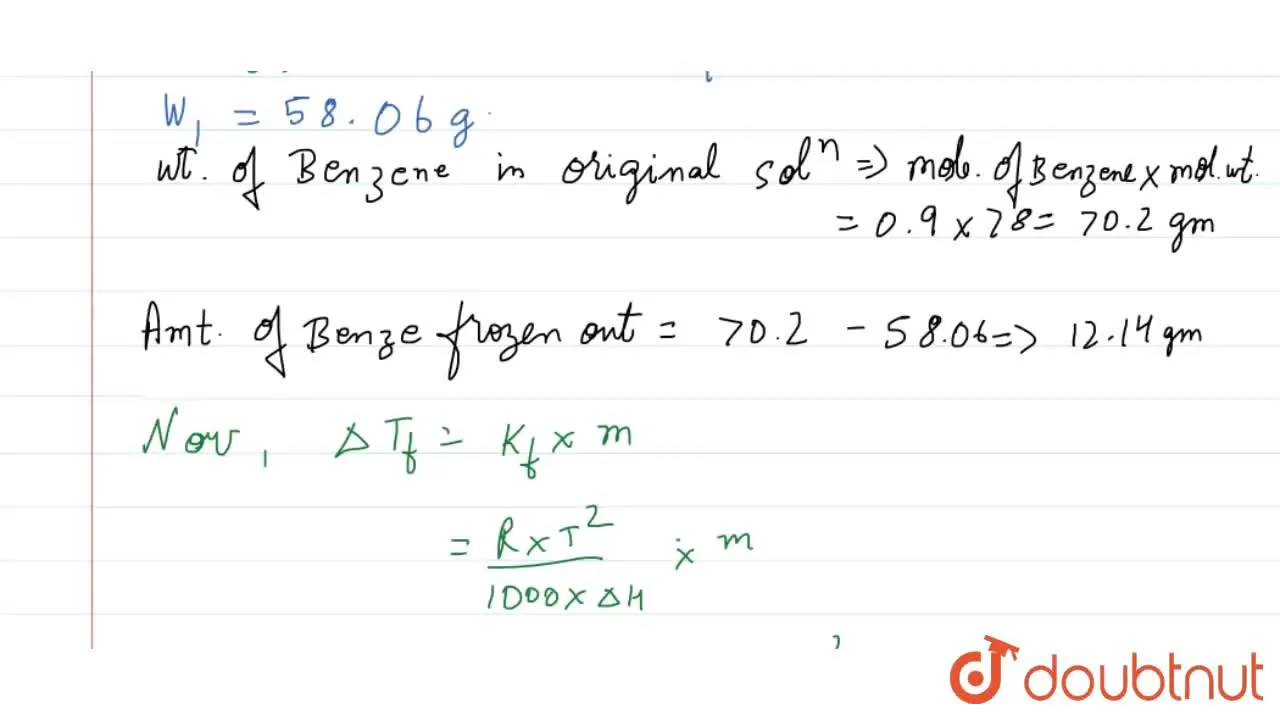A solution containing 0.1 mol of naphthalene and 0.9 mol of benzene is cooled out until some benzene freezes out. The solution is then decanted off from the solid and warmed upto 353K where its vapour pressure was found to be 670mm. The freezing point and boiling point of benzene are 278.5K and 353K respectively, and its enthalpy of fusion is 10.67KJmol−1. Calculate the temperature to which the solution was cooled originally and the amount of benzene that must have frozen out. Assume ideal behaviour.
Given, mole of napthalene (n2)=0.1
Mole of benzene (n1)=0.9
Vapour pressure of benzene (P∘)=760mm
Boiling temperature of benzene =353K
Vapour pressure of solution=670mm
Freezing point of benzene =278.5K
Enthalpy of fusion (ΔfusH)=10.67kJmol−1
Using Raoult's law:
P∘−PsPs=W2×Mw1Mw2×W1)
[W2=Weight of naphthalene
Mw2=Molecular weight of naphthalene
Mw1 =Molecular weight of benzene W1=Weight of benzene]"
760−670670=0.1×78W1,(Mole of naphthalene =W2Mw2=0.1)
∴W1=58.06g
Weight of benzene in original solution (WB)
=Mole × Molecular weight
=0.9×78=70.2g
Amount of bezene frozen out =70.2−58.06=12.14g
Now, ΔTf=Kf×m=RT2m1000ΔH
=8.314×(278.5)2100×10.67×10378×1000×0.158.06
=8.11K
Thus, original solution must have been cooled to =278.5−8.11=270.39K
Related Playlists
- BOOK - CENGAGE CHEMISTRY ENGLISHCHAPTER - SOLUTIONSEXERCISE - Exercises (Linked Comprehension)58videos
SOLUTIONS
- BOOK - CENGAGE CHEMISTRY ENGLISHCHAPTER - SOLUTIONSEXERCISE - Exercises (Multiple Correct)25videos
SOLUTIONS
- BOOK - CENGAGE CHEMISTRY ENGLISHCHAPTER - SOLUTIONSEXERCISE - Ex 2.3 (Objective)9videos
SOLUTIONS
- BOOK - CENGAGE CHEMISTRY ENGLISHCHAPTER - SOLID STATEEXERCISE - Ex 1.2 (Objective)9videos
SOLID STATE
- BOOK - CENGAGE CHEMISTRY ENGLISHCHAPTER - SURFACE CHEMISTRYEXERCISE - Archives Subjective2videos
SURFACE CHEMISTRY
Similar Questions
What is the percent by mass of iodine needed to reduce the freezing point of benzene to 3.5∘C? The freezing point and cryoscopic constant of pure benzene are 5.5∘C and 5.12Km respectively.
View SolutionA certain solution of benzoic acid in benzene boil at 82.6∘C and freezes at 3.1∘C. What information about the no of particiles and the structure of benzoic acid at the two temperature can be deduced from the above data ? The boiling point and freezing point of pure benzene are 180.1∘Cand5.5∘C respectively.
Kr=5.12kkg/mol,kb=2.67k kg/ mol.View SolutionGiven that the latent heat of fusion of naphthalene is 19.0KJmol−1 and its melting point is 80.2∘C.Estimate the solubility of naphthalene in benzene at 76.2∘C.
View SolutionA solution at 20∘C is composed of 1.5 mol of benzene and 3.5 mol of toluene. If the vapour pressure of pure benzene and pure toluene at this temperature are 74.7 torr and 22.3 torr, respectively, then the total vapour pressure of the solution and the benzene mole fraction in equilibrium with it will be, respectively:
View SolutionThe freezing point of 0.02 mole fraction acetic acid in benzene is 277.4K. Acetic acid exists partly as dimer. Calculate the equilibrium constant for dimerization. The freezing point of benzene is 278.4K and the heat the fusion of benzene is 10.042kJmol−1. Assume molarity and molality same.
View SolutionThe freezing point depression of 0.1 molal solution of acetic acid in benzene is 0.256 K , Kf for benzene is 5.12 K Kg mol−1. What conclusion can you draw about the molecular state of acetic acid in benzence ?
View SolutionThe freezing point of a 1.00m aqueous solution of HF is found to be −1.91∘C. The freezing point constant of water, Kf, is 1.86Kkgmol−1. The percentage dissociation of HF at this concentration is:-
View SolutionThe freezing point depression constant of benzene is 5.12 K kg mol−1. The freezing point depression for the solution of molality 0.078m containing a non-electrolyte solute in benzene is
View Solution1.0g of non-electrolyte solute dissolved in 50.0g of benzene lowered the freezing point of benzene by 0.40K. The freezing point depression constant of benzene is 5.12kgmol−1. Find the molecular mass of the solute.
View SolutionA certain solution of 1m benzoic acid in benzene has a freezing point of 3.1∘C and a normal boiling point of 82.6∘C. The freezing point of benzene is 5.5∘C. And its boiling point is 80.1∘C. Analyze the state of the solute (benzoic acid ) at two temperature and comment .
View Solution


